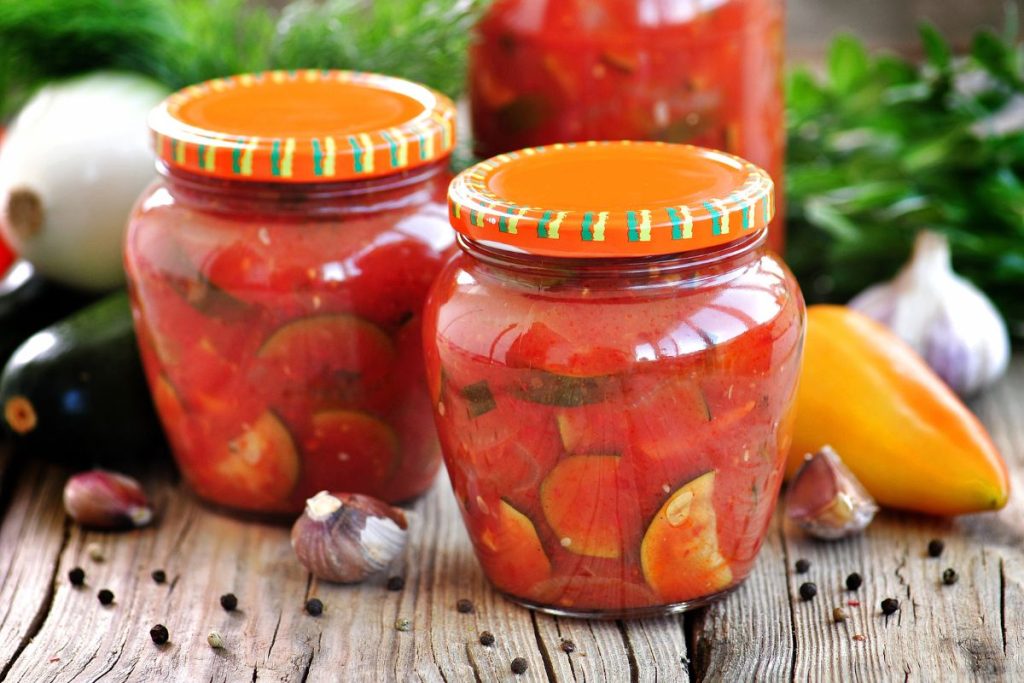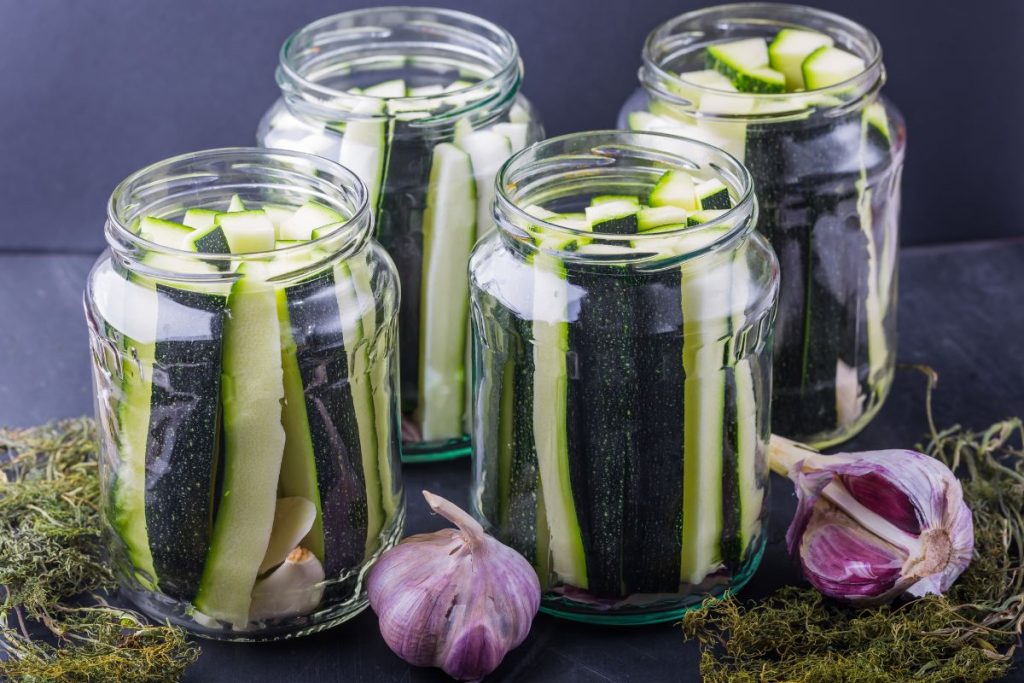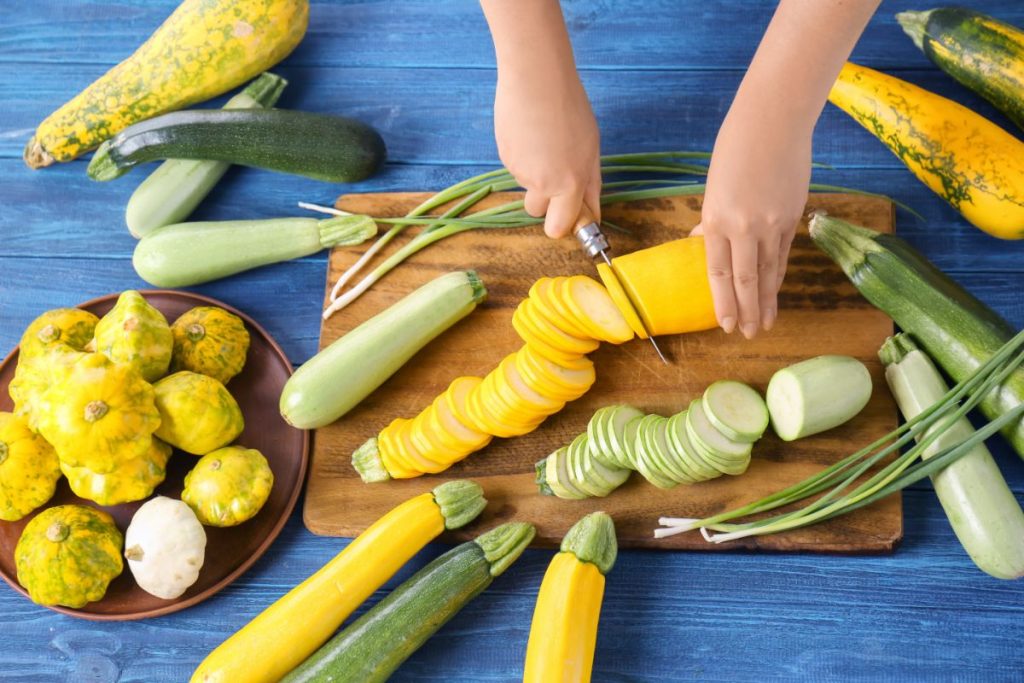Zucchini is a low-acid vegetable that develops a soft texture when cooked. For this reason, it is best to can zucchini with tomatoes in a pressure canner or acidify and pickle zucchini before canning it in a water bath canner.
What is the Best Way to Can Zucchini?
The best method for canning zucchini is pickling it and processing it in a water bath canner. You can also make pineapple zucchini in a boiling water bath by mixing it with pineapple juice, sugar, and lemon juice.
The USDA advises against pressure canning summer squash or zucchini due to the lack of established processing times for safe preservation. Zucchini can only be safely pressure canned when combined with tomatoes.
Pressure Canning Zucchini with Tomatoes Guide
Here’s a step-by-step guide for pressure canning zucchini and tomatoes:
- Gather zucchini, tomatoes, canning jars, lids, bands, a pressure canner, a sharp knife, a cutting board, a large pot for blanching, a slotted spoon, a ladle, a timer, and a clean towel.
- Wash the zucchini and tomatoes thoroughly with cold water. Trim the ends of the zucchini and remove any blemishes. Core the tomatoes and remove the stems. Peel the tomatoes if desired.
- Boil a large pot of water and blanch the zucchini for 2 minutes. Remove the zucchini with a slotted spoon and cool them in a bowl of iced water. Drain and set aside.
- Sterilize the canning jars, lids, and bands by boiling them in water for 10 minutes. Keep them in hot water until ready to use.
- Fill the sterilized jars with alternating layers of zucchini and tomatoes. Leave about an inch of headspace.
- If desired, add a small amount of boiling water or tomato juice to each jar, leaving 1 inch of headspace.
- Use an air bubble remover tool to remove air bubbles.
- Wipe the jar rims with a damp, clean cloth to ensure a proper seal.
- Put the lids on the jars and screw the bands on until fingertip tight.
- Add 2-3 inches of water to the pressure canner according to the manufacturer’s instructions. Place the canning rack inside and transfer the filled jars into the canner with a jar lifter.
- Close the pressure canner lid and allow the canner to vent steam for 10 minutes before allowing the pressure to build to the appropriate level based on elevation and the type of canner:
Recommended process time in a dial-gauge pressure canner.
| Altitude (ft) | 0 – 2,000 | 2,001 – 4,000 | 4,001 – 6,000 | 6,001 – 8,000 |
| Pints (30 mins) | 11 lbs | 12 lbs | 13 lbs | 14 lbs |
| Quarts (35 mins) | 11 lbs | 12 lbs | 13 lbs | 14 lbs |
Recommended process time in a weighted-gauge pressure canner.
| Altitude (ft) | 0 – 1,000 | 1,001 + |
| Pints (30 mins) | 10 lbs | 15 lbs |
| Quarts (35 mins) | 10 lbs | 15 lbs |
- Process pints for 30 minutes and quarts for 35 minutes.
- After the processing time, switch off the heat and leave the canner to depressurize naturally. Wait until the pressure indicator shows that it’s safe to open.
- Take the jars out of the canner using jar lifters and place them on a towel-lined surface. Allow the jars to stand and cool for 12 to 24 hours.
- After cooling, press the center of the lids to check they are properly sealed. Any lids that don’t pop back indicate a successful seal. Label the jars and put them in a dark, cool place.

Can Zucchini Be Canned in a Water Bath?
Zucchini is a low-acid vegetable, and water bath canning alone is not advised as it does not provide the necessary temperature to destroy harmful bacteria, such as Clostridium botulinum, which can cause botulism.
To safely can zucchini in a hot water canner, it is recommended to pickle them first. The pickling process involves adding vinegar (white vinegar is ideal), which increases the acidity of the zucchini, making it suitable for water bath canning.
How To Make Canned Zucchini Pickles
Here’s a step-by-step guide on how to make canned zucchini pickles:
- Gather and wash the zucchini thoroughly and trim off the ends. Dice the zucchini or cut it into spears or coins.
- Make the pickling brine in a saucepan by combining 2 cups of vinegar, 2 cups of water, 3 tablespoons of pickling salt or canning salt, and 2 tablespoons of sugar. Bring the mixture to a boil, stirring until the salt and sugar dissolve. Take the saucepan off of the heat and set it aside.
- Wash canning lids and bands in warm, soapy water and rinse well. Sterilize the canning jars by boiling them in water for 10 minutes. Keep them in hot water until ready to use.
- Place mustard seeds, dill seeds or fresh dill, and garlic cloves into each jar. Pack the sliced zucchini tightly into the jars, leaving ½ inch headspace.
- Using a canning funnel, carefully transfer the hot pickling brine into each jar, covering the zucchini and maintaining the 1/2-inch headspace.
- Use a bubble remover tool or wooden stir stick to remove air bubbles.
- Wipe any debris from the jar rims using a damp, clean cloth.
- Screw the lids on the jars and tighten the bands until fingertip tight.
- Prepare a boiling water bath canner by filling it halfway with water and bringing it to a rolling boil. Place a canning rack inside it and transfer the filled jars to the large pot of boiling water, ensuring the jars are completely submerged.
- Process jars for 10-20 minutes per altitude:
| Altitude (ft) | 0 – 1,000 | 1,001 – 6,000 | 6,000 + |
| Pints | 10 minutes | 15 minutes | 20 minutes |
| Quarts | 10 minutes | 15 minutes | 20 minutes |
- After processing, carefully remove the hot jars from the boiling water with tongs or a jar lifter and place them on a towel-lined surface. Let them cool undisturbed for 12-24 hours.
- After cooling, remove the screw bands and check that the lids have a proper seal by using your thumb to press down on the center of each lid. Any lids that don’t pop back indicate a successful seal.
- Label the jars and store them in a cool, dark place.

What are the Advantages of Canning Zucchini?
Canning zucchini offers several advantages:
- Convenience: Canned zucchini can be stored for a long time, providing a convenient ingredient for various recipes.
- Preservation: Canning allows you to extend the shelf life of zucchini and enjoy it throughout the year.
- Self-sufficiency and cost savings: Canning zucchini at home allows you to take control of your food preservation, reducing reliance on expensive store-bought canned goods.
- Versatility: Canned zucchini can be used in many recipes, including soups, stews, casseroles, sauces, and side dishes.
Does Canning Zucchini Make It Too Soft?
Canning zucchini can result in a softer texture compared to fresh zucchini. The heat and extended cooking time involved in the canning process can cause the zucchini flesh to become more tender.
Can Frozen Zucchini be Canned?
You should not can frozen zucchini. When zucchini is frozen, the water content in the vegetable expands, which can result in a softer texture upon thawing. This change in texture makes frozen zucchini unsuitable for canning.
How Long Does it Take to Can Zucchini?
Canning zucchini takes 2 hours, including 90 minutes of prep time and 20-30 minutes of processing time. Canned zucchini also requires 12-24 hours of cooling before storage.

How to Store Canned Zucchini
Store zucchini by placing it in a cool, dry place. Avoid placing it near stoves or anywhere near natural light sources. The best temperature range for storing canned zucchini is 50°F to 70°F.
Properly canned zucchini can be stored for 1 to 2 years, although the quality and flavor may gradually decline over time. You should consume canned zucchini within a year if you wish to enjoy it at its best quality.
What Is The Shelf Life Of Canned Zucchini?
The shelf life of zucchini is 1-2 years. According to the National Center for Home Food Preservation and the USDA, it is best to consume canned goods within 12 months for the best flavor. Canned goods stored beyond one year may begin to lose quality.

